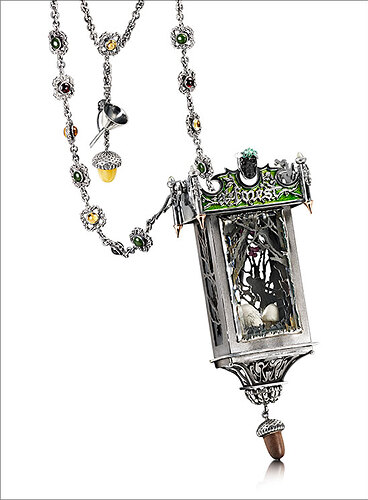Materials: Found, scrap metals: steel, pure iron, copper, nickel, stainless steel; gold; silver; porcelain; Victorian glass; acrylic enamel; reclaimed oak wood; amber, emerald, onyx, ruby, citrine, jade, garnet; custom-blended perfume.
Dimensions: Chain length, 880mm (34"); box height 200mm (8"), including drop on base; box width 80mm (3"); box depth 60mm (2.25")
Pendant in the form of a box - a tiny theatre - which contains an interpretation of the lyrics to the song “A Forest” by English pop group, “The Cure”, using recycled materials, gemstones and porcelain.
The image behind the glass is that of a girl running through a mystical forest of trees hung with gemstones and golden leaves; porcelain mushrooms sprout from the ground.
Below the piece, concealed in the ornate base is a perfume diffuser which holds a few drops of a specially-blended “forest” perfume.
Photo credit: Andrew Neilson
Dauvit Alexander
The Justified Sinner
Glasgow, Scotland. UK
Rusty bolts lie by the side of the road. A coffee jar filled with corroded spring washers sits on the windowsill of a disused engineering works. Someone throws a cast-iron fencing spike into a skip. A piece of pitted steel washes up on the beach.
These are not the images normally associated with the worlds of either “commercial” or “art” jewellery but they are the sources of the material for most of my work. Combining these materials with precious metals and gemstones, using the skills of the traditional fine jeweller, I aim to make pieces which are aesthetically pleasing, technically interesting and, if possible, humorous: if they happen to be not just a little unsettling or disturbing, so much the better.
My jewellery is primarily aimed at men. Even in the supposedly free world in which we now live, jewellery for men is circumscribed by what footballers and actors wear, reported by magazines, filtered through a corrupting veil of media; men dare not strike out for fear of being tagged an outsider, a loser, effeminate… Using what would traditionally be seen as masculine materials iron, steel from traditionally masculine backgrounds the road, the building site, the machine-shop I look back to the last time men could freely wear jewellery: the Renaissance.
Renaissance jewellery was a glorious, allegorical, blackly humorous, alchemical mess. It was a triumph of skill and material over taste. It mixed precious with semiprecious with worthless, a riot of colour and shape. It was huge and overblown. It verged on the unwearable, comfort sacrificed, preferring to make statements about the wearer’s beliefs, power and money. So it is with my own work: it takes a bold person to wear a piece by The Justified Sinner.
These containers and vessels definitely hold their place in the world of stunning art objects as well as in the world of metalsmithing.
Since the dawn of time humans have created containers to hold things that were important to them, from large vessels to hold food and harvests to intimate containers for small precious things. They might hold memories, ashes, medicine, beverage, fruit or food - but all spring from the imagination and skill of the maker. Some have specific religious functions, some are meant for everyday use. When one thinks of a vessel or container the inclination is to think of something with solid walls - yet many of these works involve the exploration of positive and negative space, and the use of negative space to help create the illusion of the wall of the vessel.
As the world’s largest jewelry related internet site, Ganoksin strives to develop exhibitions showcasing work from around the world. This exhibition was open to all metalsmiths, professional and amateur, advanced and beginner. Participants are from The Netherlands, the USA, Canada, Australia, Costa Rica, the United Kingdom, Israel, Hong Kong, Colombia, Romania, Italy, Ireland, Japan, Malaysia and Denmark. While most of the pieces are by an individual metalsmith, some are collaborations, one of three artists spanning 50 years.
In total 319 artists contributed 729 show pieces for the permanent online exhibition.
Objects in the exhibition include boxes, lockets, urns, ash containers, bowls, wine cups, reliquaries, match holders, vases, teapots, pitchers, sugar bowls, baskets, nests, pillboxes, clutches and a range of sculptural forms. A variety of techniques are showcased covering a wide range of metalsmithing techniques. Materials used include everything from gold and silver to less expensive metals. Ornamentation includes the addition of enamel, chasing and repousse’, gemstones and found objects.
The exhibition was curated by Beth Wicker, President of the North Carolina Society of Goldsmiths in the United States, and Adjunct Instructor at Northeastern Technical College in South Carolina. Director of the exhibition is Hanuman Aspler, founder of The Ganoksin Project, the world’s largest internet jewelry site.
